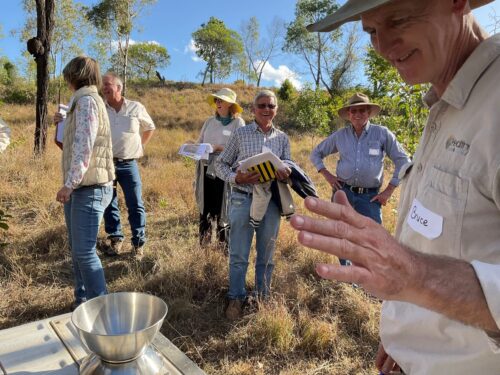Accurate starting yield is key to forage budgeting
Attendees of recent Stocktake workshops were astonished to learn the benefits of conducting multiple pasture cuts when estimating starting yield for forage budgeting purposes.

Why it’s important to take the time
“Getting your starting figure as accurate as possible is key to having confidence in your dry season forage budget,” said DAF Senior Beef Extension Officer, Greg Bath. “Although using pasture yield photo-standards is helpful, until you get your eye in by conducting a few pasture cuts, you are likely to be under or over estimating. If you’ve under estimated, there will be a missed grazing opportunity, but if you’ve over estimated, your cattle will be forced to eat plant stems instead of leaves. In this case, not only will the diet quality be greatly reduced, but the growing points on the plants will be removed, delaying the plants’ response to rain when growing conditions are next ideal,” he told attendees at a recent workshop.
Don’t be tempted to cut corners
Stocktake workshop co-deliverer, Bruce Lord from Healthy Land and Water, led the pasture yield estimation activity at the recent Boonah Stocktake workshop. “It’s important to conduct a number of pasture cuts when estimating pasture yield to get a representative average of biomass in the selected area for each land type in the paddock,” Bruce said.
During the exercise, attendees threw a 50 x 50 cm quadrat randomly 10 times, cutting, collecting and weighing the contents.
“Selecting where you’re going to throw your quadrat needs to be done in an unbiased manner,” Bruce continues. “My preferred method to ensure I’m not subconsciously picking high yielding sites is to pick a direction, and drop the quadrat at the toe of my shoe every ten steps, cutting a sample there.”
When cutting the pasture that falls within the quadrat, Bruce provided the following advice:
- Using shears or clippers, cut the grass down to the ground and collect what you’ve cut into a paper bag.
- Leave out any sticks, rocks or leaf litter.
- Using kitchen scales, weigh and record your sample, minus the weight of the paper bag.
After weighing the samples, calculate an average pasture weight across the selected representative area, within the paddock.
“A little tick we use to simplify the calculation, is to multiply the average weight in grams collected in a 50 x 50 cm quadrat by 40. This multiplier converts the weight into kilograms of pasture per hectare,” Bruce shared.`
Calculating dry matter
However, this weight includes the moisture within the plants’ stems and leaves, whereas feed intake and nutrient quality of a pasture, is always measured on dry matter.
Therefore, the next step is to discount the moisture content.
“At this time of year and stage of plant maturity, we can estimate the pastures will contain about 20-25% moisture,” Bruce explained. “Although, if you can take a subsample of the cut pasture and dry it, it’s much better.”
To calculate moisture content, take a sub sample of the cut pasture, weigh it using kitchen scales before putting it in the microwave for 30 seconds with a cup of cold water, and reweigh the sample. Keep drying the sample in the microwave and weighing it, in short intervals until the weight no longer changes. Divide the difference between the start and end weight, by the end weight and multiply by 100 and you will have the per cent moisture content.
For example:
The starting weight of the pasture subsample was 590g.
After multiple sessions in the microwave, the subsample weighed only 455g
590 – 455 = 135g
135 ÷ 590 = 0.22
0.22 x 100 = 22% moisture.
Therefore, the average weight of the pasture cuts completed earlier was 78% dry matter.
“Aha” moments
After calculating the dry matter from the averaged samples, two things became clear to the participants:
- The weight of the heaviest sample was twice the weight of the lightest sample, indicating a large variation within the pasture yield at the site.
- Nearly all the participants had greatly underestimated the starting yield despite using photo standards as a guide initially.
“This is my favourite exercise of the Stocktake workshops” offered DAF Beef Extension Officer, Jodie Ward. “It shows just how important it is to be unbiased when conducting pasture cuts and how important it is to do multiple assessments at a site to get a handle on how much variation there is in the pasture within the same land type.”
Following this activity, workshop participants conducted a forage budget using the calculated dry matter pasture yield as their starting value with the Stocktake GLM app.
More information
Why forage budget and how to do it →